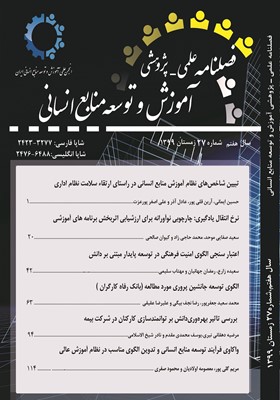نرخ انتقال یادگیری: چارچوبی نوآورانه برای ارزشیابی اثربخش برنامه های آموزشی
محورهای موضوعی :
سعید صفایی موحد
1
![]() ,
کیوان صالحی
2
,
کیوان صالحی
2
![]() ,
محمد حاجی زاد
3
,
محمد حاجی زاد
3
1 - شرکت ملی نفت ایران
2 - دانشگاه تهران
3 - دانشگاه آزاد اسلامی، واحد نکاء
کلید واژه: نرخ انتقال یادگیری, انتقال یادگیری, اثربخشی آموزش, کیفیت آموزش,
چکیده مقاله :
یکی از چالشهایی که ادارات آموزش سازمانهای تولیدی، بازرگانی، و خدماتی با آن روبرو هستند، ناتوانی در ارائه گزارش عملکرد خویش بر مبنای شاخصهایی است که نشان دهد تا چه اندازه در بهبود عملکرد کارکنان سازمان تأثیرگذار بودهاند. امروزه شاخصهایی چون نفر/ ساعت، میانگین رضایت کارکنان از دورهها، تعداد قبولشدگان در آزمونهای حرفهای، و امثالهم نمیتواند مدیران را اقناع کند که آموزش توانسته نقش تاثيرگذاري در سازمان ایفا کند. لذا این مقاله درصدد است تا بر مبنای مفهوم انتقال یادگیری، شاخص کیفی را به منظور اندازهگیری اثربخشی برنامههای آموزشی ارائهکند. این شاخص که نرخ انتقال یادگیری نام دارد با بکارگیری ضریب همبستگی پیرسون و ضریب تعیین (از طریق محاسبه نمرات یادگیرندگان در اتمام دوره و نمرات ارزیابی پيگيري عملكرد یادگیرندگان طی دورة زمانی 3 تا 6 ماه پس از دوره) قابل استخراج است (این شیوه در مقاله حاضر راهبرد خطی ساده نام گرفته است). همچنین در صورتیکه بخواهیم علاوه بر یادگیری حاصل از دوره، نقش سایر متغیرها در بهبود عملکرد را محاسبه کنیم، میتوان با بکارگیری رگرسیون چندگانه، تصویر بهتری به دست آورد (این شیوه در مقاله حاضر راهبرد خطی خوشهای نام گرفته است). مهمترین مزیت شاخص پیشنهادی این است که تحت تأثیر عوامل کمّی نظیر افزایش تعداد دورهها، نفر/ ساعت و امثالهم قرار نگرفته و صرفاً بهبود شرایط کیفی دوره (مدرس، محتوی، شرایط یادگیری، و امثالهم) و محيط كار میتواند موجب افزایش نرخ مذکور شود.
Training officials are often unable to prove how effective they are in meeting the business goals. We clearly admit that top managers need reliable and valid data to trust training functions, but training officials often lack justifiable indices to back up their claims about improving staff's performance in real work. Although ROI was a rigorous index to report on effectiveness of work-based training programs, but it did not turn into popular trend it is hard and costly to estimate. Hence, we here put forward a new index for reporting on effectiveness of work-based training programs, entitled Rate of TOL. This index aims at measuring how much of what participants learn during training programs transfers into performance in real workplaces. To do so, two strategies are suggested: firstly, Simple Linear Strategy (SLS) which is based on calculating coefficient of determination between scores of final course tests and performance appraisals; and secondly, Cluster Linear Strategy (CLS) which is based on calculating multiple regression between scores of final course tests plus other influencing predictor variables (such as work climate, personal motivation, etc.) and performance appraisals. It is finally argued that the proposed index just improves when training programs are designed and implemented in the best possible manner to meet quality measures like learners' satisfaction, relevance, importance, instructors' competency, and etc. Consequently, Rate of TOL as a quality index helps training and development officials to report more exactly and justifiably on how effective they are in improving people in real workplace.
فتحی واجارگاه، کورش و دیبا واجاری، طلعت(1395). ارزشیابی اثربخشی دورههای آموزشی، تهران: آییژ.
فیلیپس، جک و استون، رون(1393/2002)، اندازهگیری نتایج آموزش(راهنمای علمی برای پیگیری شش شاخص کلیدی). ترجمه کوروش فتحی واجارگاه، غلامرضا شمس مورکانی، و سعید صفائی موحّد. تهران: علم استادان.
کرک پاتریک، دونالد و کرک پاتریک، جیمز(1391/2005). ارزشیابی اثربخشی برنامههای آموزشی. ترجمه سعید صفائی موحّد و اعظم اسداللهی. تهران: آییژ
Aron, Arthur; Coups, Elliot J.; Aron, Elaine.N.(2013). Statistics for Psychology. Pearson Education, Inc. New Jersey.
Cramer, duncan(2003). Advanced Quantitative Data Analysis. Open university press, Berkshire Introduction to Stutistics in Psychology. Pearson Education Limited, Essex.
Holton, Elwood III(1996). The flawed four – level evaluation model. Huaman Resouurce Development Quarterly.(1) : 5-21.
Holton, Elwood F.III(2005). Holton’s Evaluation model: new edidence and construct evaluations. Advances in Developing Human Resources in Developing Human Resources.7(37) : 37-54
Holton, Elwood F.III; Ruona,Wendy E A (2000). Development of a generalized learning transfer inventory. 11(4) : 333-300
Leberman, Sarah; McDonald,Lex; Doyle,Stephanie(2006). The Transfer of Lerning. Gower Publishing Company, Burlington.
Perkins, David N.; Salomon, Garriel(1992). Transfer of Learning. In International Encyclopedia of Education. Pergamon Prress. Oxford.


